[Personal Software Services, ZX Spectrum]
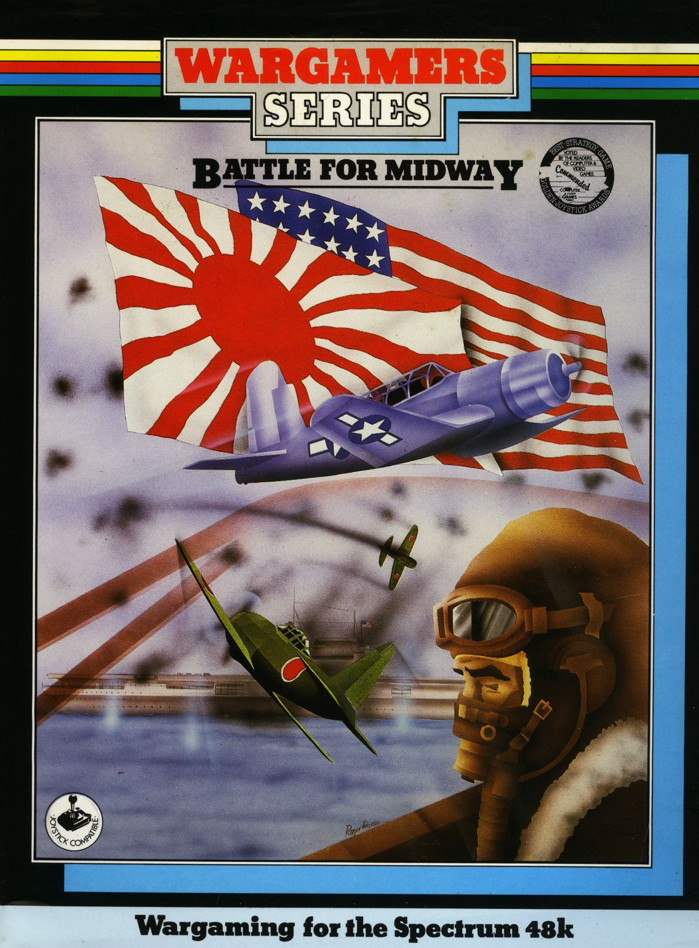
The battle of Midway is one of the most fascinating battles of WW2. In an era where decisive battles took weeks if not months to unravel, the Battle of Midway opened at around 4 AM, ended at around 6 PM, and over that time the momentum in the Pacific shifted. However, both Avalon Hill (Midway Campaign, possibly by Gary Bedrosian ) and SSI (Carrier Force by Gary Grigsby) have so far failed to make an interesting game out of the whole affair. Ken Wright’s Midway (1983) being lost media, it is the turn of unproven designer Alan Steel to try his luck.
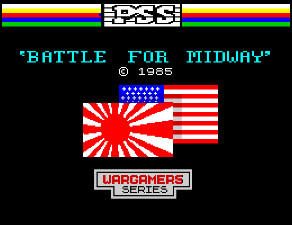
Battle for Midway starts at 4 in the morning the 4th of June 1942 with 5 assets on the map: two scouting seaplanes, the airbase on Midway and groups #1 (Task Force 16 with the USS Enterprise and the USS Hornet) and #2 (Task Force 17 with the USS Yorktown).
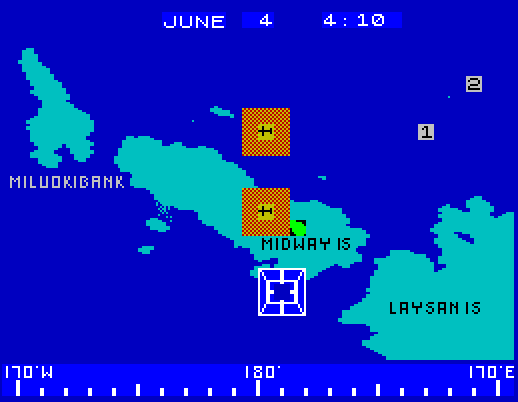
As for the Japanese, I know they have 3 fleets:
- the Battle Fleet with 3 battleships and the Light Carrier Hōshō,
- the Transport Fleet with 2 battleships and 2 seaplane carriers (the Chitose and the Kamikawa),
- the Strike Fleet with its 4 Fleet Carriers: the Akagi, the Kaga, the Hiryū and the Sōryū. That’s the main target, and the manual states that the Japanese will retreat if the Fleet Carriers are sunk.
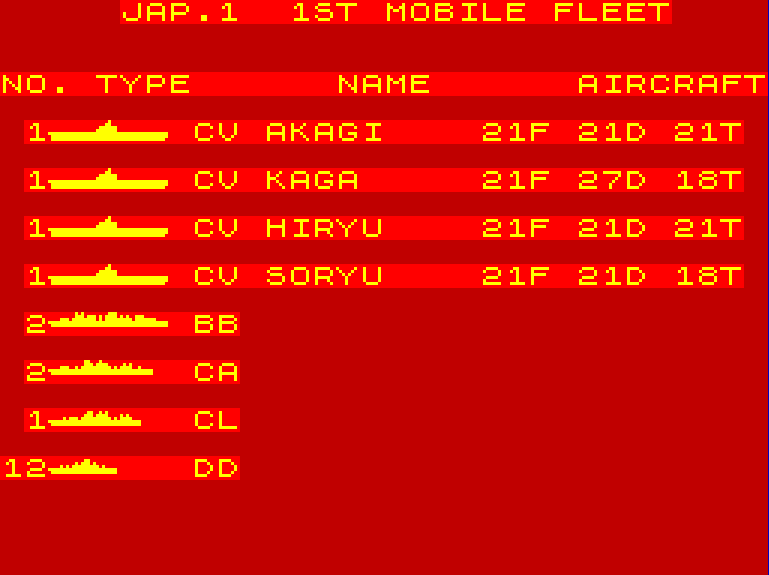
On my side, I do not field fancy battleships – because Pearl Harbor – but I have more than parity in planes with the Japanese thanks to larger carriers and of course the airbase on Midway:

The first thing I have to do in Battle For Midway is order my CAP [Combat Air Patrol] planes to take off. There is no reason not to: they don’t have any fuel limit, and as long as they have not taken off they are taking the deck slots and my bombers can’t be readied. It is pointless, but eh, it gives the player something to do.
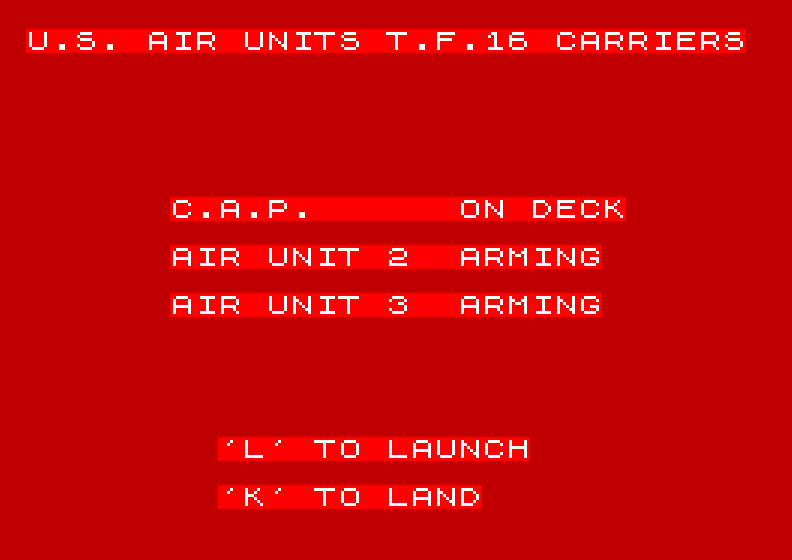
At the level of difficulty I am playing, the location of the Japanese fleets is randomized, so after ordering my two fleets to approach Midway I micro-manage my two seaplanes to comb the sea, eventually finding a Japanese fleet.
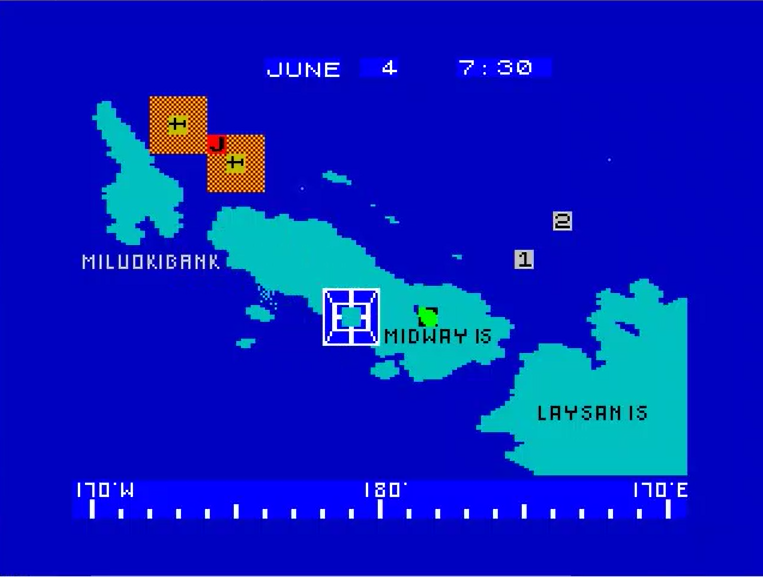
I can query a “report” on the Japanese fleet to have a better view of it:
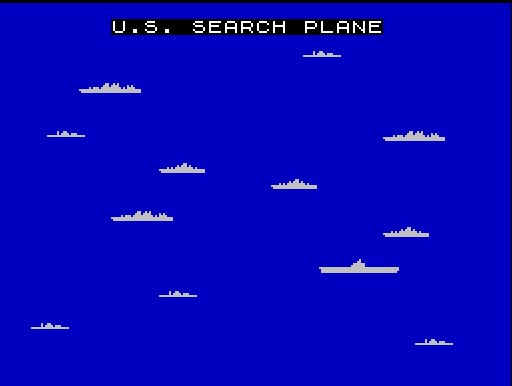
It has only one carrier, so it must be the Battle Fleet. I scramble some planes from Midway, but don’t launch the planes from my Task Forces immediately: I’d rather use them on the Strike Fleet when I find it.
Shortly after the land planes have taken off from Midway, a Japanese bomber formation attacks the island! The game lets you man the gun yourself and try to shoot enemy planes
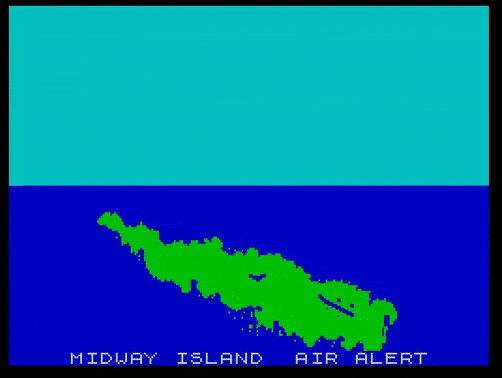
My defence is for nought: Midway is disabled. Meanwhile, my own strike force reaches the Japanese Battle Fleet:
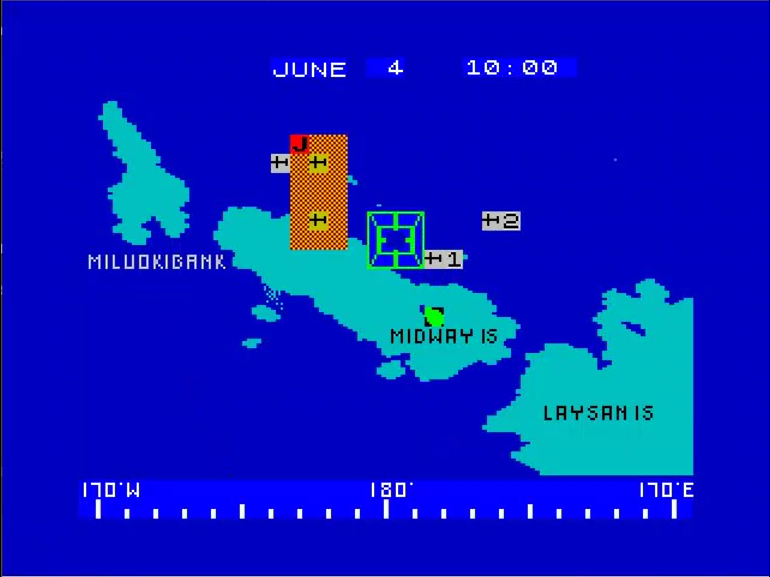
A new battle starts, and here again I can man the gun… to shoot down my own planes. As the manual explains: “You will also notice that it is possible to fire the A.A. Gun at your OWN Aircraft when they are attacking a Japanese Fleet. This feature was left in the game for the ‘Arcade Players’ who cannot resist shooting at anything that moves on the screen.“
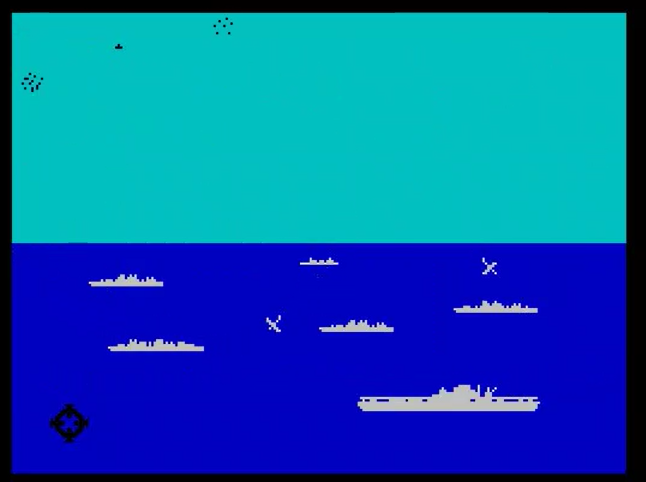
Lacking better targets, I also send the planes from the aircraft carriers to double-down on the Japanese fleet. During the attacks, I find out that the enemy aircraft carrier is no more.
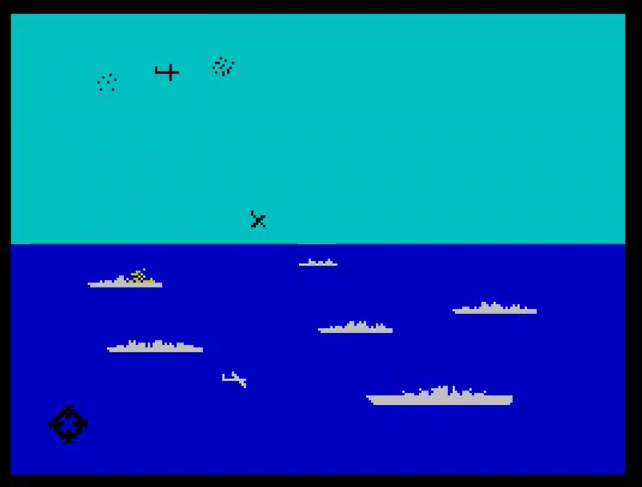
The planes launched from Midway have to ditch as their airbase has been razed, but I must manually order the planes sent from the USS Enterprise, USS Hornet and USS Yorktown to return home because, you see, “A version of the game was tried where aircraft automatically returned to refuel. This was found to take too much pressure off the player and the game was becoming a button-pushing exercise.” I am not sure this comes out as the designer intended.
I send two more waves against the Battle Fleet but don’t sink any battleship. Finally, at around 6 PM, just as I discovered a Japanese fleet next to Midway, Task Force 17 is attacked by Japanese airplanes.
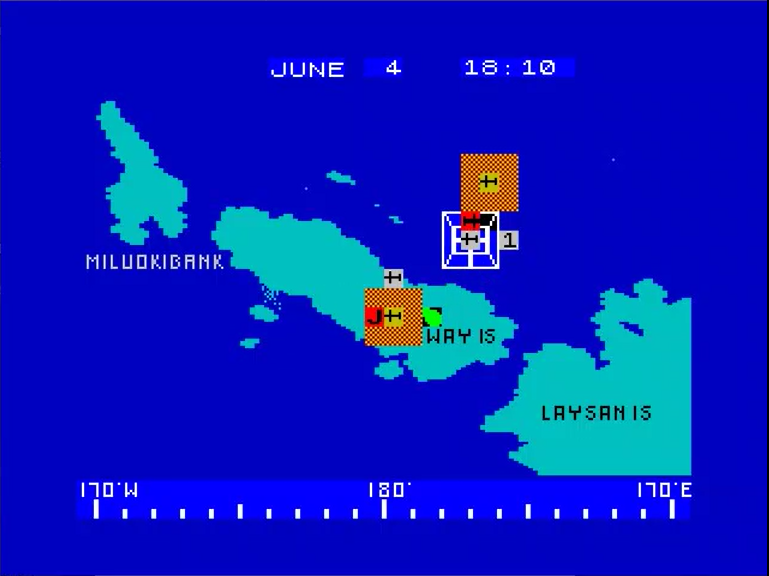
The USS Yorktown is sunk in the battle, but it could launch its planes beforehand, and these are now heading toward the Japanese fleet, which turns out to be two fleets after all:
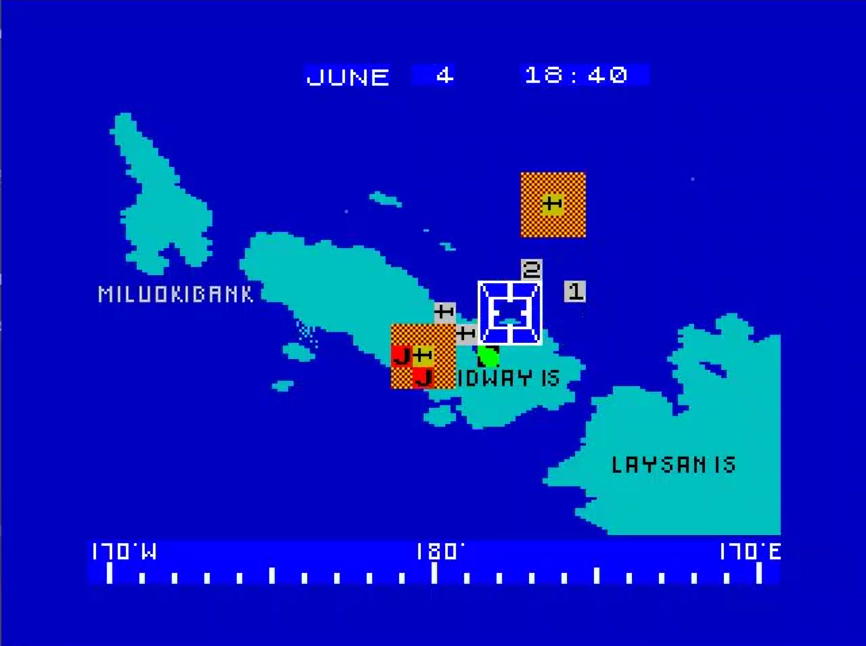
One of my air wings engages the Transport Fleet and the second one attacks the Japanese Strike Force:
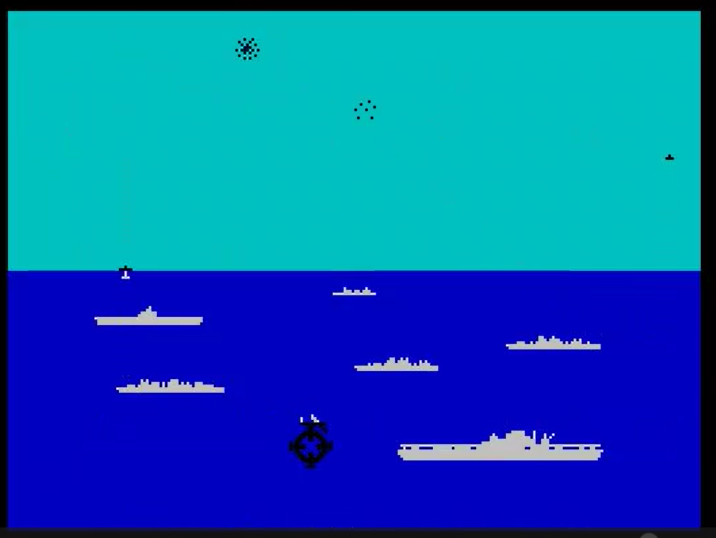
Unfortunately, I cannot check the damage, as night suddenly falls at 7 PM. My planes return to the USS Enterprise and USS Hornet.
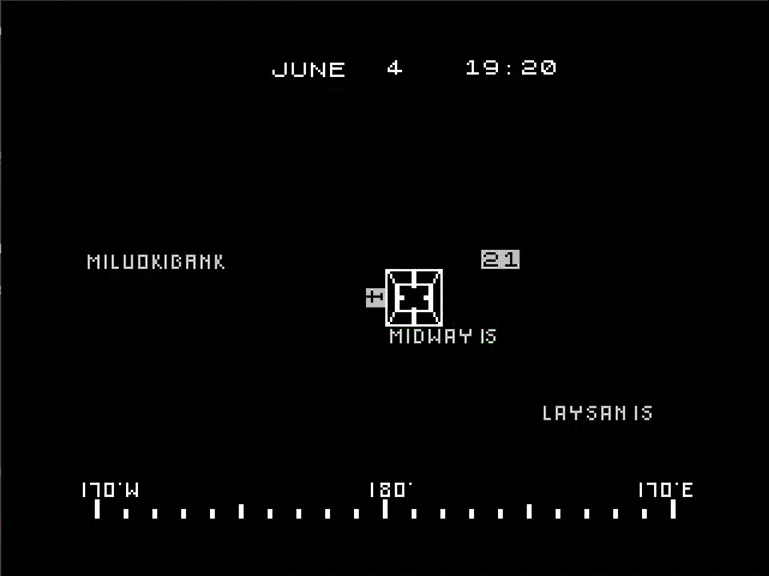
At 4 in the morning, my seaplanes are available again – they are exactly where I left them yesterday at nightfall. I quickly find the Japanese transport fleet, but the Japanese Strike Fleet eludes me…
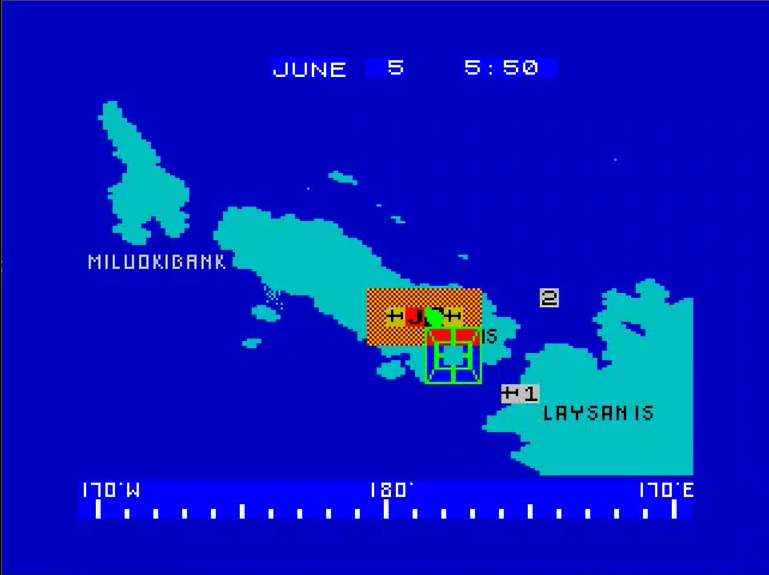
… and at 7 AM, the Japanese Battle Fleet – which should have been in shambles after 5 successive attacks – finds Task Force 16. After a short naval combat (as interesting as the air defence mini-game – except now you can shoot your own ships!), the USS Enterprise and the USS Yorktown are sunk.
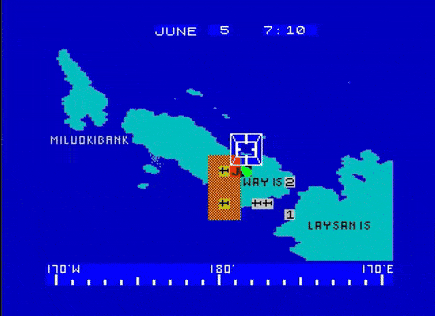
It is the end of the Battle of Midway; once again I was inadequate for the task and let the Japanese win.
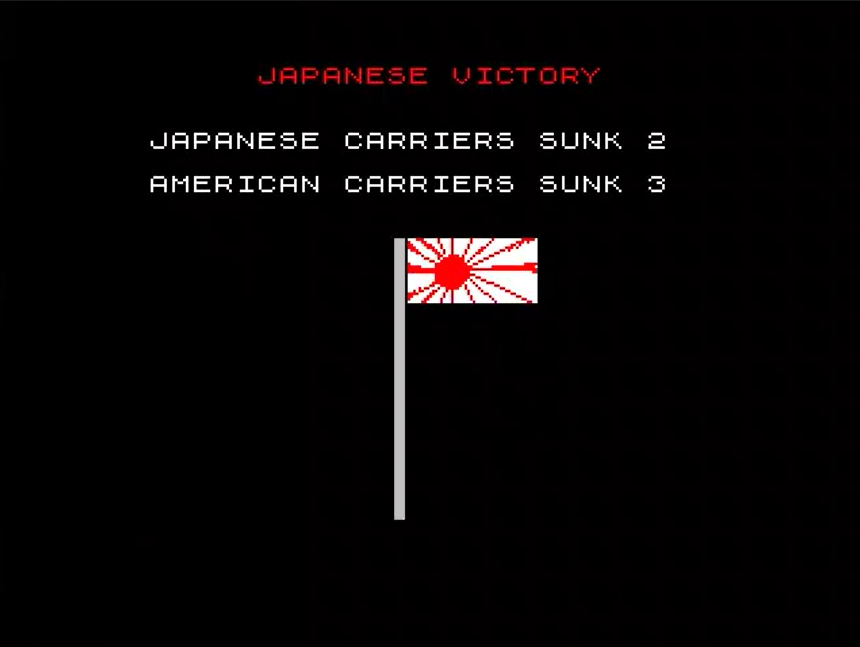
I am not trying again, thank you very much.
Rating & Review
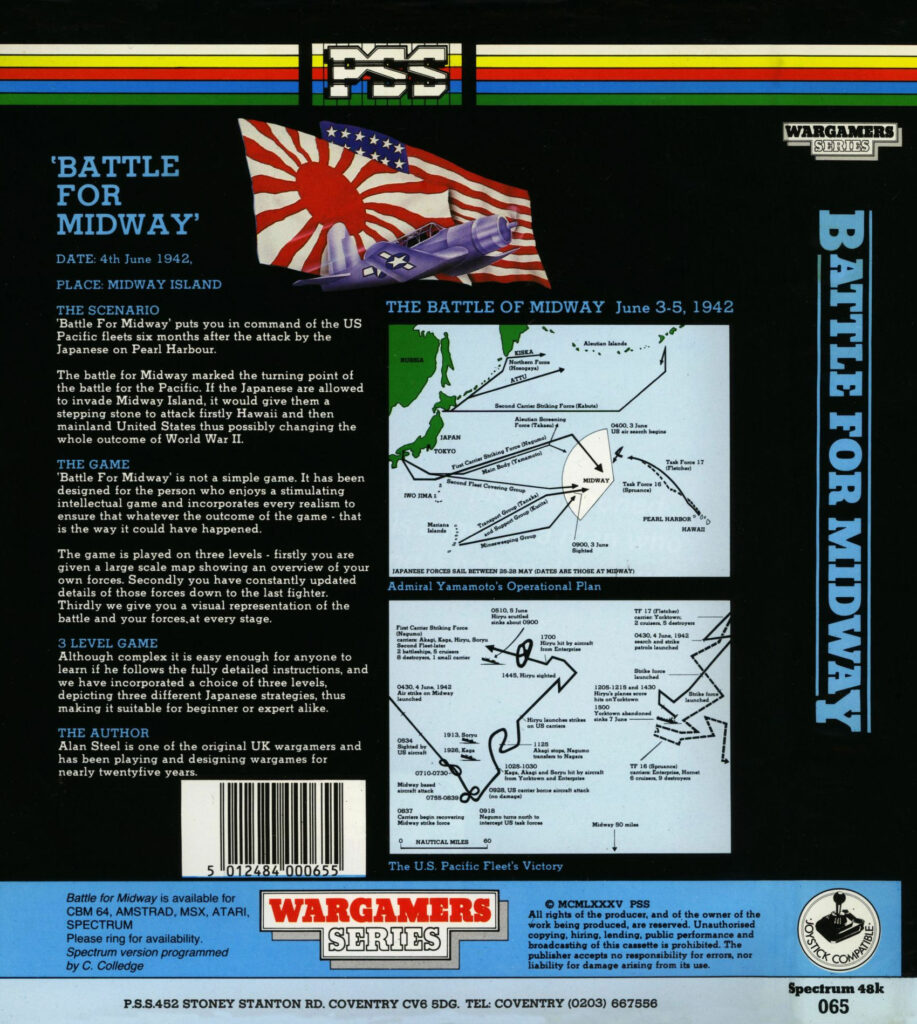
Battle for Midway by Alan Steel, published by Personal Software Services (PSS), UK
First release: September 1984 on Commodore 64
Genre: Naval Operations
Average duration of a campaign : 30 minutes at speed 2 (game speed can be modified at launch)
Total time played: 45 minutes
Complexity: Low (1/5)
Rating: Totally obsolete
Ranking at the time of review: 124/143
In late 1981, two Warwich University graduates in Management Studies, Gary Mays and Richard Cockayne, decided to move from theory to practice by creating their own software company. The vision did not go much further from that, but personal computing was booming, and riding the tide seemed like a good move. After testing various dead-end ideas, for instance a “software library” (“All you have to do is join the ZX Software Library for a membership free of £15.00 and decide which package you want first and we will then dispatch it to you immediately and it is yours to use for up to one year. When you feel like it, simply choose your next tape from the update lists you will receive, return your original tape and we will forward you your next choice and so on up to a maximum of 10 packages per membership“), Mays and Cockayne fell back on what everyone was already doing: mail-order direct sales of software submitted to PSS by developers!

The initial catalogue of PSS was eclectic, as Mays and Cockayne were presumably still probing the market for what would stick, and were not in a position to be picky anyway. The catalogue included unabashed clones of famous titles without even a name change, oddly specific utilities (“French“, “Accounts“) and possibly more valuable programs “to simplify complex programming”. Nothing distinguished PSS from its competitors advertising similar products and similar magazines.
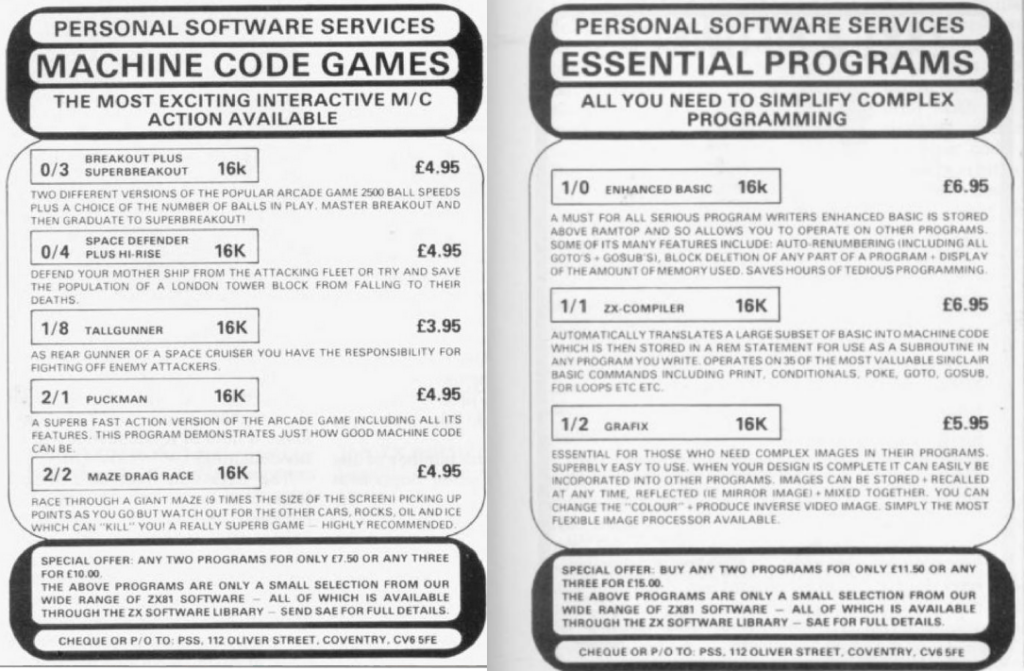
The breakthrough was called QSave, a ZX81 hardware tool sold between £15 and £20 that could Load/Save in only 26 secs. Mays and Cockayne might not have been the most tech-savyy entrepreneurs of the era, but they knew what to do with such a banger. Starting in August 1984, their ads focused almost exclusively on this amazing piece of technology, of which they ultimately sold 2000, PSS had taken off, and late 1982 the founders could move into a real office and started recruiting.
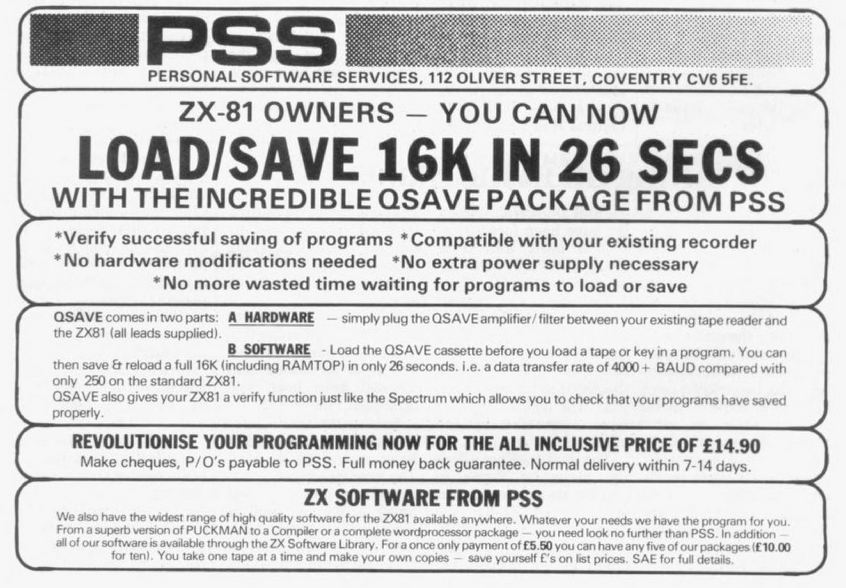
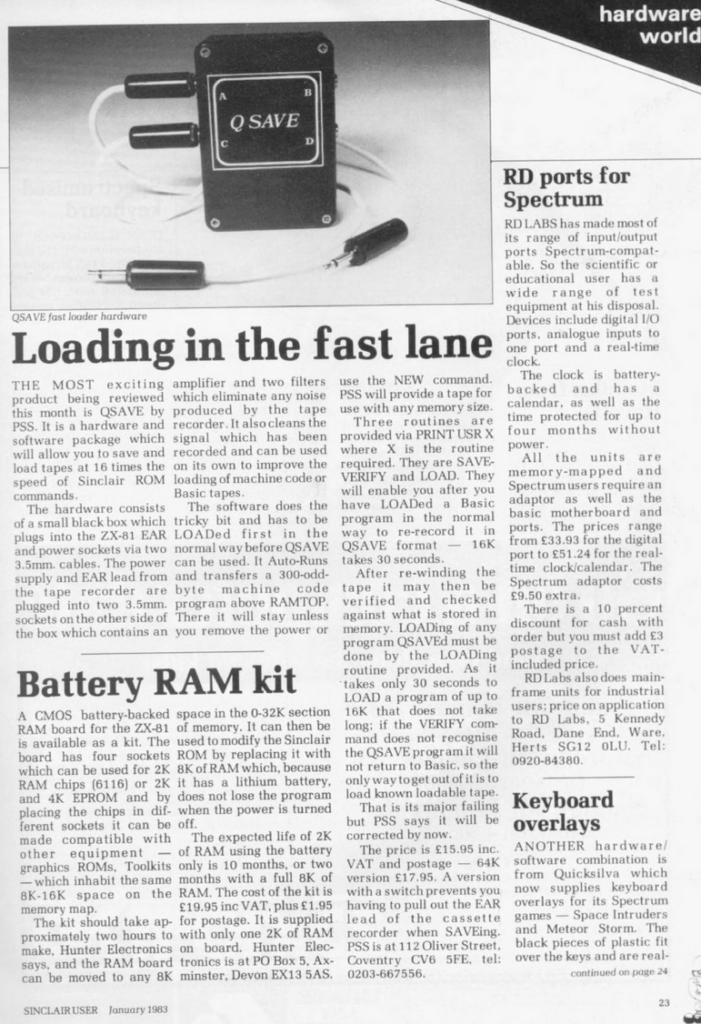
Mays and Cockayne had a lucky roll with QSave – of course, their “fail fast” approach had maximized their odds to eventually be lucky – but after that, their management flair took the helm. The duo understood the flimsiness of their new niche: mail-order would not be popular for long and the ZX81 was an increasingly obsolete machine. To solve the latter issue, they recruited a sales manager as early as Q1 1983 to pilot the transition from mail-order to retail. As for the ZX81 obsolescence, the solution was simply to propose game software for other platforms: the Dragon, the Spectrum and the BBC Micro. The diversification paid the bill and more, but PSS did not break through again the way it had done with the ZX81. Surmising that the correct strategy was to arrive early on a popular platform, Mays and Cockayne eyed the Commodore 64, which offered good prospects: it was a new computer in the UK that could become big. Striving to get that sweet first-mover advantage, Cockayne flew to the Consumer Electronic Show in Chicago in June 1983 to pick up software directly from the American programmers.

The move to the Commodore paid off, and PSS had found its new staple platform. There was however one last change for PSS to reach its final form. Mays and Cockayne had grown frustrated with external developers, their unreliable delivery dates and their unpredictable reactions to feedback and so pivoted PSS toward in-house development. Around that time, Alan Steel, “wargamer since he was 16” and that’s all I found about him, contacted PSS with the idea for a game he could both design and code: Battle for Midway.
It is not clear whether Mays and Cockayne wanted to position PSS on the wargaming niche before meeting Steel – possibly Mays just wanted to do wargames because he liked the genre and PSS had the cash – but once the decision was taken PSS went all-in on the marketing front. First, they would not just take a slot of the niche with a one-off title, they planned to occupy all of it as Battle for Midway would be the first opus of the Wargamers Series. Moreover, possibly taking their cue from SSI, the game was sold not as a cassette with the manual wrapped around it as was still standard in the UK, but in a premium plastic case, one of the first games sold this way in the UK. This helped justify a hefty price: £9.95 for the cassette version, £12.95 for the disk version, but then the typical wargamer was expected to have more purchasing power.
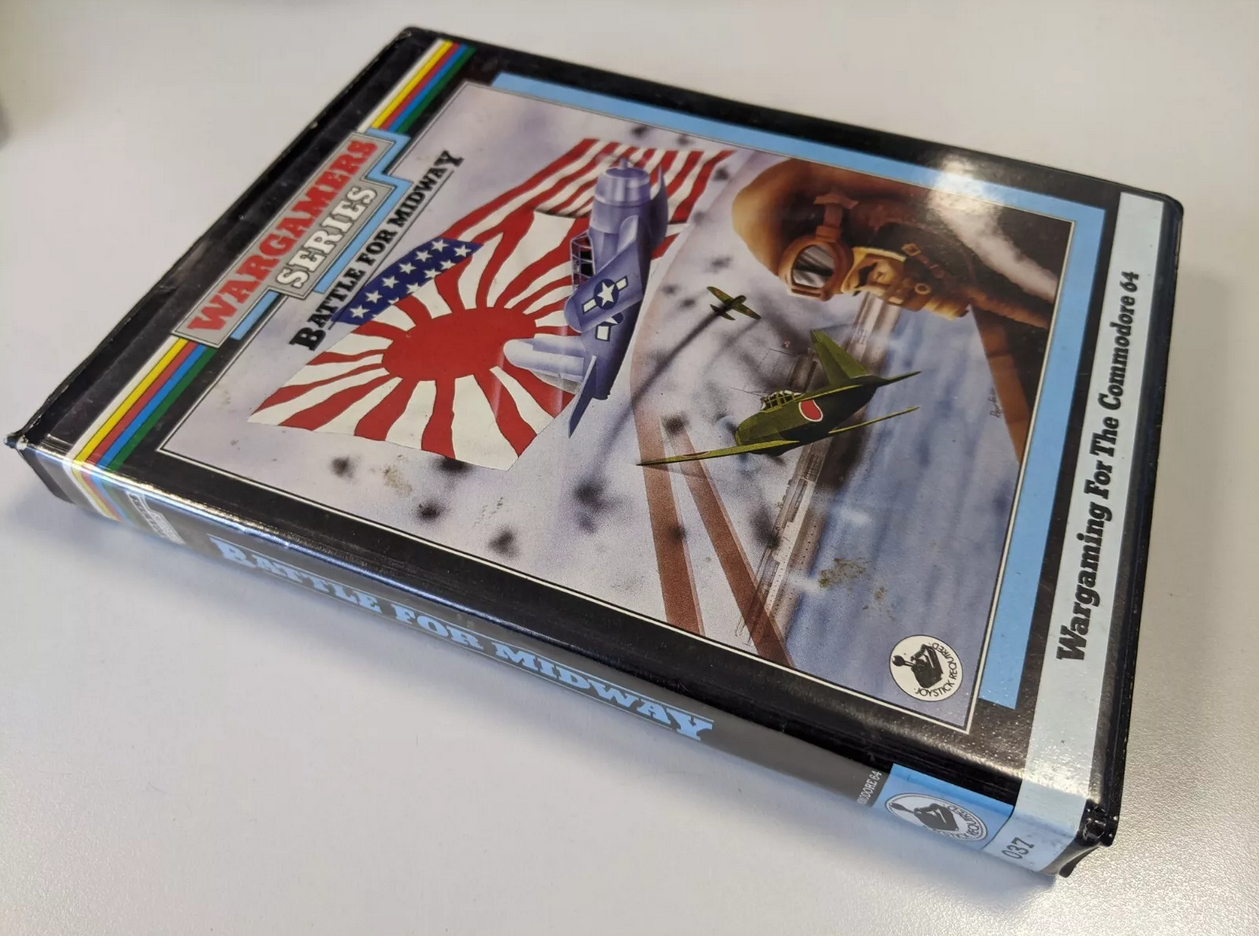
Battle for Midway, the first game of the Wargamers Series,was first released on Commodore 64 (September 1984), and later ported on Spectrum, MSX and Amstrad CPC. It was also, in a rare instance for a British game, fully translated in French by ERE Informatique, a company with which PSS signed in 1985 a bi-directional distribution agreement – but more on this in a future article.
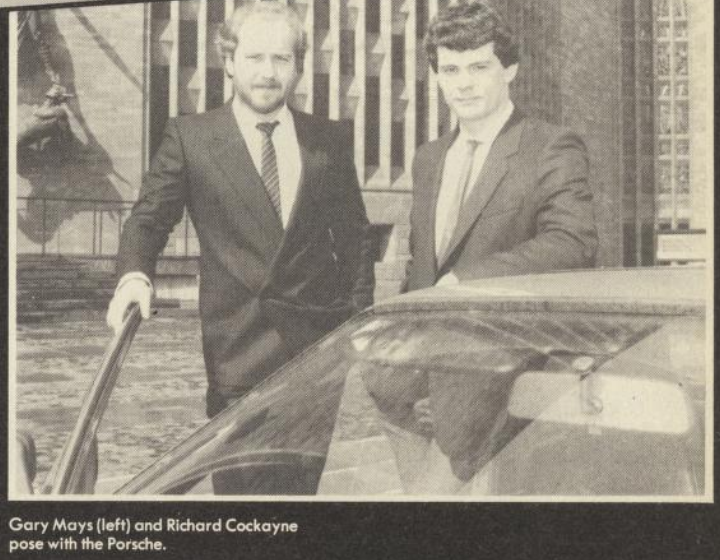
Traits – The most peculiar aspect of Battle for Midway is undoubtedly its arcade component. Some reviewers have noted that this feature is make-believe, with no impact on the actual outcome of the battle. It is hard to test, but very likely true, as much of the game’s mechanics are faked. In my own testing, I discovered that whenever you attack the Japanese Strike Force, you always destroy exactly one carrier. On the other hand, enemy battleships can’t be sunk: after attacking the Battle Fleet six times in a row, all four battleships were still seen by my planes.
I am more intrigued by the existence of an arcade section in the first place; I surmise without any proof that PSS was deep down not so confident in the commercial prospect of a wargame (almost all their previous games were arcade) and so it awkwardly edged its bet. As for letting you shoot your planes and ships during battles, I don’t believe for one second it is for the benefit of the trigger-happy players as the manual claims – a tailgunner gameplay where you defend your planes from fighters would have done the trick. On my side, I call that a lazy recycling of code, or maybe a way to stretch the game by having attack animations, and then justifying these animations by making them interactive.

Ultimately, Battle for Midway is shallow. If you remove the noise, arcade or not, Battle for Midway is only about finding and sinking the Japanese Strike Fleet before the Japanese find you. Neutralizing the Light Carrier Hōshō escorting the Battle Fleet may help a little, but everything else is irrelevant: the end game score only counts the carriers sunk, so attacking the transport fleet is useless – you can’t stop it from attacking Midway – and as I explained you can’t sink the battleships anyway.

Did I make interesting decisions? No
Final rating: Totally obsolete. Battle for Midway plays similarly to Avalon Hill’s classic Midway Campaign from 1980, but aside from being able to control your scout planes, it underperforms its predecessor in every aspect. Battle for Midway forces you into trivial actions, such as sending CAP planes or recalling aircraft after they’ve dropped their bombs, while stripping away the few meaningful decisions of Midway Campaign like plane allocation. Moreover, Battle for Midway‘s gameplay is sluggish, bogged down by long attack animations which don’t even create any of the tension of Midway Campaign as their outcome is completely deterministic.
Reception
I could find almost 20 reviews for Battle for Midway; I suppose as a part of a deliberate strategy by PSS to send copies of the game to every magazine that ever wrote the word “computer”. The ratings were all over the board, but I suppose that for PSS there was no such thing as mediocre publicity. This time, I am fully aligned with Angus Ryall writing for Crash (July 1985): his conclusion says “Reasonable debut [for PSS in wargaming]” but the review is a series of jabs: “a vast amount of wargame has been jettisoned to make way for an arcade section which is petty and pointless”, but also “totally irrelevant to the rest of the game and irritating in the extreme.” Due to this, “there is not enough of a game there“: “that is more or less all the strategy there is in the game: locate the enemy, launch aircraft, blast enemy, land aircraft.” I reordered the punchlines, but it is clear that Ryall does not really think the game is in any shape or form a reasonable debut.
On the other end of the rating spectrum, we can find for instance the French Tilt, which in March 1985 describes the Battle for Midway as belonging to a new generation of wargames with action phases between the strategic phases. The game is simple but “captivating” – the game earns 5 stars, as many as Gary Grigsby’s simulations.
Between those two extremes, I could read reviews corresponding to various degrees of “mediocre”, “fair” and “good” ratings. Most of the reviewers complained about the lack of strategical depth but the jury was divided on the combination of strategy and arcade: some found it innovative, others inappropriate for a wargame. Among the latter, the votes were split between those who found it pointless and a few who were convinced that the game could not be won without being good in the arcade phases.
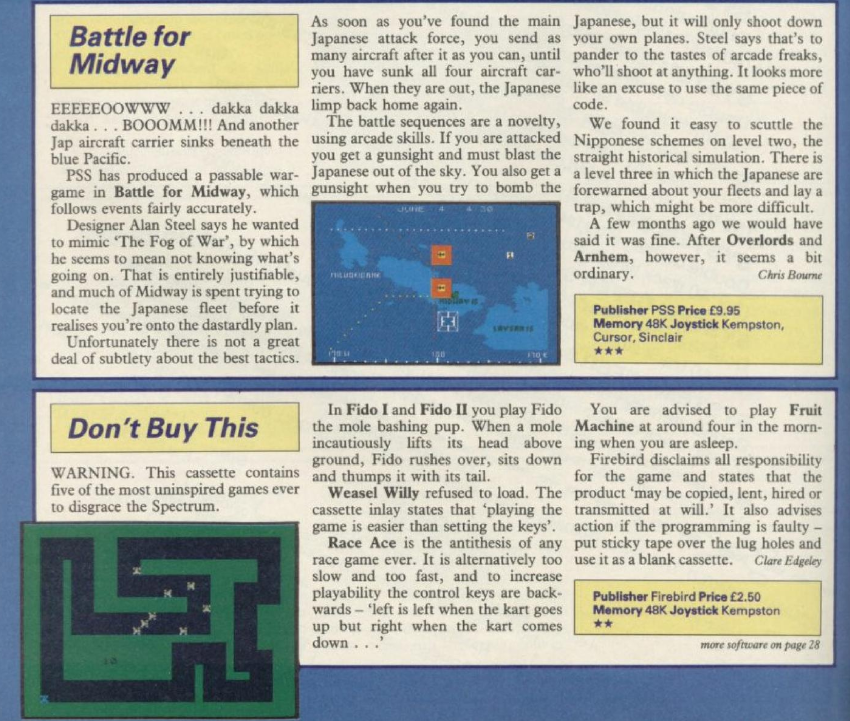
Despite not acing its reviews, Battle for Midway sold according to Mays an incredible 45 000 copies in its first 15 months, which shows the impact of a solid marketing strategy in an era where most competitors were hoping to sell their games with a few ads in a magazine – those management degrees certainly paid off. This success ensured that the Wargamers Series would actually be a series and not a stand-alone, and PSS is going to be a regular of this blog, starting soon with a backtrack to Alien (1983) on ZX81.
Sources for the history of PSS:
PSS and MSX, Your Computer, January 1984
Crash, June 1984
Your Commodore, Behind Closed Doors, November 1984
Amtix, Interview with Gary Mays, May 1986
Amstrad Action, March 1986, PSS